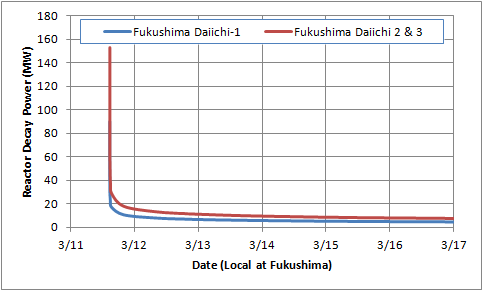Explanation of Nuclear Reactor Decay Heat
Nuclear reactors produce electricity in a similar way to conventional coal plants in that they heat steam to drive a turbine that spins an electric generator. However, they differ on how that heat is produced. Coal plants burn coal to heat a boiler that produces the steam while nuclear reactors use nuclear fission to create the heat. The Fukushima reactors are boiling water reactors (BWRs) that produce the steam directly in the reactor core, which then drives the turbines.
The heat in an operating reactor is produced mainly by the fission of fissile isotopes such as uranium-235 and plutonium-239. When a neutron causes one of these isotopes to split, a large amount of energy is released, which is then deposited in the fuel, cladding, coolant, and structures. On average, approximately 80% of the energy released in a fission reaction is imparted to the two or more fission products and these deposit their energy in the fuel since they have a very short range. The rest of the energy is released in the form of neutrons, and other forms of radiation.
When there is a SCRAM, where all the control rods are inserted and the reactor is shutdown, the fission reactions essentially stop and the power drops drastically to about 7% of full power in 1 second. The power does not drop to zero because of the radioactive isotopes that remain from the prior fissioning of the fuel. These radioactive isotopes, also called fission products, continue to produce various types of radiation as they decay, such as gamma rays, beta particles, and alpha particles. The decay radiation then deposits most of its energy in the fuel, and this is what is referred to as decay heat. As these radioactive isotopes continue to decay, more and more of them reach a stable state and stop emitting radiation, and thus no longer contribute to the decay heat.
The decay heat must be removed at the same rate it is produced or the reactor core will begin to heat up. The removal of this heat is the function of the various reactor core cooling systems that provide water flow through the reactor core and then reject the heat elsewhere. However, at the Fukushima site the integrity of these systems were compromised by the large tsunami that resulted from the earthquake, and made it difficult for the operators to keep up with removing the decay heat.
The amount of the decay heat expected at various times after shutdown is well known. Below is a figure and a table that show an estimate of the decay heat of Fukushima Units 1-3 in MW as time has progressed since the earthquake. This data is not produced from measured data on the actual reactors at Fukushima, but from using a simplified model that estimates the behavior relatively well. The data is likely to be somewhat conservative, so a more accurate model (i.e. 2005 ANS Standard or ORIGEN simulation) would correctly estimate lower powers.
Approximate reactor decay heat vs. time. The curves begin after the SCRAM of the reactors (complete and rapid control rod insertion) that occurred immediately after the earthquake.
Tabulation of approximate decay heat for the Fukushima reactors from 1 second after the scram caused by the earthquake until 1 year after the event.
Date/Time (Fukushima Time)Fukushima Daiichi-1 Decay Heat (MW)Fukushima Daiichi-2 & 3 Decay Heat (MW)Percent of Full Reactor Power3/11/11 2:46 PM89.8153.16.45%3/11/11 2:47 PM42.572.53.05%3/11/11 2:48 PM34.759.12.49%3/11/11 2:50 PM29.249.82.10%3/11/11 3:00 PM21.937.31.57%3/11/11 3:30 PM16.928.81.21%3/11/11 8:00 PM10.718.20.77%3/12/11 8:00 AM8.013.60.57%3/12/11 8:00 PM7.011.80.50%3/13/116.711.50.48%3/14/115.89.90.42%3/16/114.98.30.35%3/20/114.06.90.29%4/1/113.05.20.22%7/1/111.62.70.11%10/1/111.22.00.08%3/11/120.81.40.06%
Fukushima unit 1 has an electrical rating of 460 MWe and units 2 and 3 have an electrical rating of 784 MWe. However, due to various thermodynamic and practical constraints, the efficiency of the plants is only about 33%. Therefore, they have thermal ratings (MWth) about 3 times that of the electrical ratings and this thermal energy is the energy that must be removed, and is what is shown in the figure and table above. The decay heat drops off very slowly after about 1 day where the decay power is already below 1% of the operating power of the reactor. After a year the decay power is about 0.06% of the operating power of the reactor.
If the decay heat is not removed then the reactor fuel begins to heat up and undesirable consequences begin as the temperature rises such as rapid oxidation of the zircaloy cladding (~1200C), melting of the cladding (~1850C), and then the fuel (~2400-2860C).

